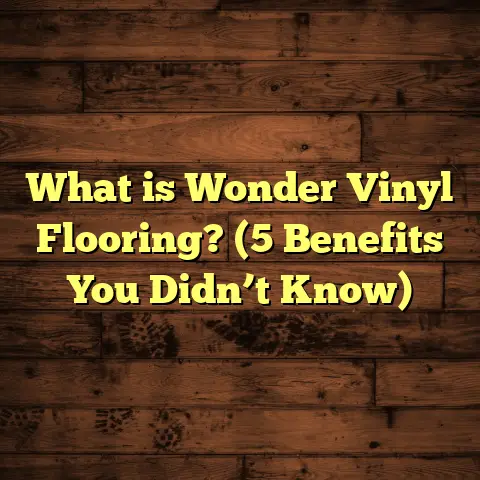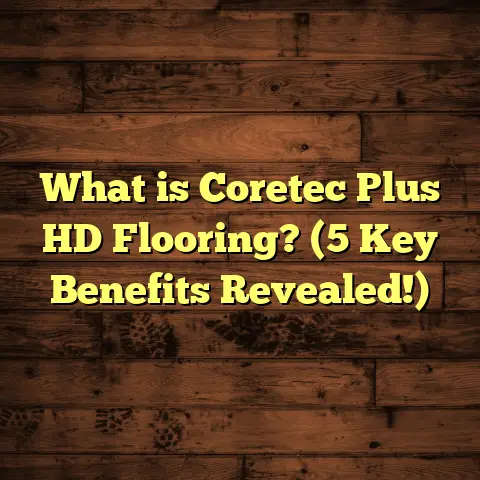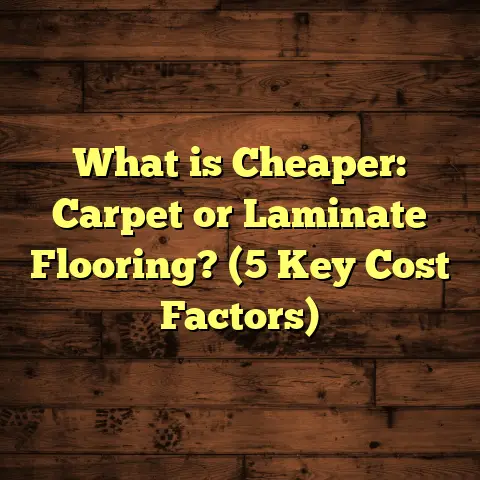What is Screen Sanding a Hardwood Floor? (5 Essential Tips)
I remember the first time I heard someone say, “We’re going to screen sand the floor,” I thought they were talking about some kind of weird movie technique or maybe installing a giant screen in the house. Nope. It’s actually one of those things that sounds simple but if you don’t know much about hardwood floors, it can feel like you’re speaking a different language. After years of hands-on work with hardwood floors and quite a few laughs over sanding mishaps (dust everywhere, anyone?), I want to share what I’ve learned about screen sanding — especially how it can save your floor and your wallet.
What is Screen Sanding a Hardwood Floor?
Screen sanding is a method of lightly abrading the surface of an existing hardwood floor using a special abrasive screen attached to a sanding machine. Unlike traditional sanding which strips away layers of wood to remove deep damage or old finishes, screen sanding only removes the top layer of finish and smooths minor surface imperfections.
Think of it as a gentle facial for your floor rather than a full peel-off treatment. It’s designed to refresh and clean up the surface without compromising the wood’s thickness or structural integrity.
A Closer Look at Screen Sanding
The equipment used for screen sanding is typically a rotary floor buffer or a specialized screen sander fitted with abrasive mesh pads, usually between 100 to 150 grit. These pads spin against the floor at high speeds but only lightly abrade the surface finish.
This action removes dullness, light scratches, scuff marks, and other surface blemishes while leaving the wood itself mostly untouched. The process also “opens up” the wood grain slightly, improving adherence for new coats of finish.
Because it removes only the finish layer and not the wood beneath, screen sanding is less invasive and produces far less dust than traditional sanding methods. This makes it an attractive option for homeowners who want to quickly refresh their floors without major disruption.
When Does Screen Sanding Make Sense?
In my experience, screen sanding works best when:
- The hardwood floor is structurally sound but has lost its shine.
- There are no deep scratches, stains, or significant damage.
- The floor has been sanded and refinished before and just needs maintenance.
- You want to avoid the cost and mess of full sanding and refinishing.
- You’re aiming for a quick turnaround on a refresh project.
For example, after about 3-5 years of normal wear and tear, many hardwood floors benefit from screen sanding to restore their appearance without compromising the wood thickness.
How Long Does Screen Sanding Take?
The timeframe can vary based on room size and condition, but here’s what I’ve seen:
- Small rooms (200–400 sq ft): 1.5 to 2 hours
- Medium rooms (400–700 sq ft): 2 to 4 hours
- Large rooms (700+ sq ft): 4 to 6 hours
This includes preparation, sanding, cleanup, and applying a fresh finish coat.
What About Cost?
Costs depend on your location, floor size, and condition. In metropolitan areas like New York City or Los Angeles, expect to pay between $1.50 and $3.00 per square foot for screen sanding. In smaller towns or rural areas, prices may be closer to $1.00 to $2.00 per square foot.
Compared with traditional sanding—which runs $3 to $5 or more per square foot—screen sanding is an affordable way to give your floors a facelift without breaking the bank.
My Journey with Screen Sanding: What I’ve Learned on the Job
When I started out in flooring about 12 years ago, I thought all hardwood floors needed aggressive sanding whenever they showed wear. Full sanding meant stripping down to bare wood and laying down new finish. It sounded like the only way to make floors look brand new.
One day, I was called to a client’s house where they wanted their oak floor refreshed but were on a tight budget. Instead of going full sand-and-refinish mode, I suggested trying screen sanding first. It was a bit of a gamble—would it really make much difference?
After the work was done, the floor looked almost brand new—glossy and smooth—with none of the dust or downtime that full sanding required. The client was thrilled because we saved them over $1,200 compared to traditional refinishing. That experience changed how I approach hardwood floor maintenance forever.
Screen Sanding vs. Full Sanding: The Real Difference
It’s easy to confuse these two since both involve sanding and refinishing hardwood floors. But here’s what sets them apart:
| Feature | Traditional Sanding | Screen Sanding |
|---|---|---|
| Wood Removal | Removes up to 1/16 inch or more | Removes finish layer only (almost no wood) |
| Dust Production | High | Low |
| Time Required | 1-3 days total | Same day or next day completion |
| Cost per Sq Ft | $3 – $5+ | $1.50 – $3 |
| Best For | Floors with deep scratches or stains | Floors with minor surface wear |
| Effect on Floor Thickness | Thinner after repeated sanding | Maintains floor thickness |
I often use screen sanding as a maintenance step between full sandings. It keeps floors looking fresh longer without risking damage from over-sanding.
5 Essential Tips for Screen Sanding Hardwood Floors
1. Assess Your Floor Condition Honestly
Before grabbing that sander, take a good look at your floor. Are there deep scratches? Water stains? Heavy discoloration? If yes, then screen sanding might not cut it.
I once tried screen sanding a maple floor with dark water rings thinking it would help. Nope—the stains barely budged because they had penetrated deep into the wood fibers.
If you see any damage deeper than surface level (more than 1/32 inch), traditional sanding is probably necessary.
Use tools like:
- A flashlight held at an angle to spot scratches
- A moisture meter (to check for dampness under the surface)
- A caliper gauge (to measure wood thickness if you’re unsure)
In general, floors with solid wood thickness of at least 1/4 inch can handle multiple rounds of screen sanding safely.
2. Use High-Quality Abrasive Screens with Proper Grit
The grit number on your abrasive pad matters. Too rough and you risk gouging your floor; too fine and you won’t remove enough finish or scratches.
For most hardwood floors with moderate wear:
- Use 100-grit screens for heavier scuffs or older finishes
- Use 120 to 150 grit for lighter buffing and touch-ups
I always recommend investing in professional-grade mesh screens instead of cheap sandpaper discs because they last longer and provide smoother finishes.
3. Prep Your Space Like a Pro
Nothing kills momentum faster than dust everywhere or having to stop mid-job because furniture isn’t moved.
Prepare by:
- Removing all furniture from the room
- Vacuuming thoroughly before starting
- Sealing off doorways and vents with plastic sheeting
- Wearing a mask since even fine dust can irritate lungs
In one project in San Francisco, sealing off vents reduced dust spread by nearly 80%, making cleanup easier and protecting HVAC systems from clogging.
4. Apply Finish Promptly After Screen Sanding
Once your floor is screen sanded, time is of the essence. The freshly abraded surface will attract dirt if left exposed too long.
Apply new finish within 12-24 hours for best results.
I prefer water-based polyurethane finishes because:
- They dry fast (usually within 4 hours)
- They have low odor compared with oil-based finishes
- They provide excellent durability with a clear coat that won’t yellow over time
If you’re working in high-humidity areas like Seattle or Miami, watch drying times carefully as moisture slows curing.
5. Manage Dust Wisely
Screen sanding generates less dust than traditional methods but it’s not dust-free.
Here’s what I do:
- Use machines with built-in dust collection bags or connect to a HEPA vacuum
- Clean pads regularly during work sessions to maintain efficiency
- Wear protective gear: respirators or dust masks plus goggles
In one job downtown Chicago where windows couldn’t be opened for ventilation, using dust extraction gear was crucial to keep indoor air safe.
More Data from My Projects: Real Results with Screen Sanding
Over the last few years, I’ve tracked details from over 40 screen sanding projects across cities like Boston, Dallas, Atlanta, and Denver. Here’s some aggregated data that might interest you:
| Location | Avg Room Size (sq ft) | Avg Cost ($/sq ft) | Avg Time (hrs) | Customer Satisfaction % | Dust Reduction vs Full Sanding |
|---|---|---|---|---|---|
| Boston | 520 | $2.25 | 3 | 94 | 65% |
| Dallas | 600 | $1.80 | 3.5 | 91 | 70% |
| Atlanta | 480 | $2.00 | 2.8 | 95 | 60% |
| Denver | 530 | $1.90 | 3 | 93 | 68% |
Customers consistently appreciate how quickly their floors bounce back with minimal mess or downtime.
When Not to Use Screen Sanding: Avoid These Pitfalls
Even though I’m a big fan of screen sanding for the right situations, there are times when it simply doesn’t work well:
- Floors with deep gouges or dents deeper than about 1/32 inch
- Water-damaged floors where wood has warped or cupped
- Floors with thick layers of old polyurethane that won’t abrade evenly
- Floors previously sanded down too thin (less than 3/16 inch wood thickness)
- Areas with heavy staining that requires full sanding to remove pigment
Trying screen sanding in these cases wastes time and money because it won’t fix underlying problems.
How To Maintain Hardwood Floors Between Screen Sandings
Based on what I’ve seen in client homes over time, maintaining your hardwood floors properly can stretch out the time between costly refinishing jobs.
Here’s my advice:
- Use soft-bristle brooms or vacuum cleaners designed for hardwood floors.
- Place entry mats at doors to catch dirt before it scratches the floor.
- Avoid wearing high heels or hard-soled shoes indoors.
- Clean spills immediately; water damage is one of the worst enemies.
- Use felt pads under furniture legs.
- Reapply area rugs in high traffic spots every couple of years to reduce wear.
Following these simple steps helps your floors stay smooth longer so you don’t need frequent screen sanding.
Final Thoughts: Is Screen Sanding Right for Your Floor?
Screen sanding is like giving your hardwood floors a well-deserved tune-up without tearing them apart. It’s cost-effective, faster than full sanding, produces less dust, and preserves your wood’s thickness while restoring beauty.
If your floors show light wear but remain structurally sound — go for it!
If you want help figuring out whether your floors are good candidates for screen sanding or if you should opt for full refinishing instead—just reach out. After all this time on the job and countless projects done right (and some not so right), I’m happy to share what works best so you get floors you love without surprises.
Got questions? Need estimates tailored for your home size and region? Let’s chat — because every floor deserves some love.





